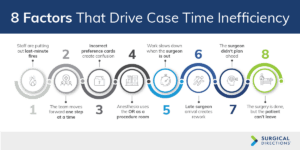Last Updated October 21, 2024
The Problem: Long Case Times Drive Down OR Volume
Many hospital leaders understand the problem of inefficient turnover in the OR. Long gaps between cases lead to low utilization and weak revenue. Few leaders, however, pay attention to a closely related issue — long average case times.
How long should surgery take? That depends on the procedure, the patient and other factors. Within any hospital OR, however, there is usually a wide variation in average operative time between the most efficient and the least efficient surgeons. This variation is not connected to quality. Studies have linked extended case time to poorer patient outcomes.
Why surgical case time matters
Long average case time is not just an OR issue — it is a hospital leadership issue. Case time inefficiency can have a negative effect on hospital economics.
Compare two hospital surgery departments (see table at bottom). Each department runs 8 rooms and has an average contribution margin per procedure of $6,500. Hospital B’s average case time is 10% less than Hospital A’s. This allows Hospital B to accommodate 7% more cases with the same resources.
The bottom line is that a relatively small difference in average case time can add or subtract millions of dollars in surgical services revenue. Unfortunately, many hospital ORs find themselves on the losing side of this scenario.
How do you get from typical inefficiency to exceptional performance? The first step is to understand the root causes of long surgical case times.
8 Factors That Drive Case Time Inefficiency

- Staff are putting out last-minute fires. In many ORs, staff members are constantly scrambling to find missing labs and verify medical clearance. If a patient has already entered the OR, these issues add time to the case.
- The team moves forward one step at a time. OR processes often proceed sequentially when they could take place simultaneously. For example, staff may clean the room, then set up the instrument table, and then bring in the patient.
- Incorrect preference cards create confusion. The supplies required for each procedure are specified on the surgeon preference card. When preference cards are inaccurate, supply set-up takes extra time.
- Anesthesia uses the OR as a procedure room. In many hospitals, anesthesia providers place central lines, do epidurals and perform other procedures in the operating room. This takes up time in the hospital’s most expensive setting.
- Work slows down when the surgeon is out. Many surgeons arrive at the OR in time for incision and leave immediately after close. However, time studies have shown that when the surgeon is absent, OR staff members slow down significantly.
- Late surgeon arrival creates rework. Observation has shown that surgeons who arrive after patient prep often request changes in set-up and patient positioning. This avoidable rework extends case preparation.
- The surgeon didn’t plan ahead. Efficient surgeons develop a surgical plan before every procedure. But some surgeons may not even look at films until they are in the surgical suite. This takes up valuable OR time and increases the risk of unanticipated problems.
- The surgery is done, but the patient can’t leave. If the PACU is full, patients may need to wait in the OR after their procedure is complete. Oftentimes the PACU is backed up because of inpatient bed constraints. Either way, post-op bottlenecks add expensive minutes to case time.
“In many ORs, staff are constantly scrambling to find missing labs and verify medical clearance.”
Measuring Case Time
Many hospitals measure surgical case time from incision to closure. However, defining case time as “cut to close” makes it impossible to track all the factors that create wasted time in the OR. The appropriate definition of case time is “wheels in to wheels out.” This metric pro-vides a comprehensive measure of OR case time efficiency.
Negative Effects Spread Across the Organization
We know that case time inefficiency suppresses case volumes and OR revenue. It also increases labor costs relative to production, resulting in low OR profitability. This is bad news for the organization overall, since most hospitals depend on surgical services to deliver the bulk of revenue and margin.
Long case times also have a negative effect on the internal dynamics of the OR. It’s important to understand that surgeons do not control all of the factors that lead to long case times. Many surgeons are frustrated by their inability to be more productive in the OR. Surgeons often end up transferring their volume to more efficient ORs where a day of surgery can generate more income.
The good news is that these problems are not irreversible. Many hospitals have improved OR operational efficiency and financial outcomes by reengineering perioperative processes. Recently, an orthopedic specialty hospital in New York City accomplished a dramatic performance turnaround by addressing the root causes of case time inefficiency.
Case Study: NYU Langone Medical Center Hospital for Joint Diseases
The Hospital for Joint Diseases (HJD) is an orthopedic specialty hospital in Midtown Manhattan. In 2013, HJD launched an ambitious effort to increase OR volumes. A key goal was to increase patient throughput by improving efficiency. Reducing average case time was critical.
HJD’s initial step was to create a Surgical Services Executive Committee (SSEC) to govern the OR. One of the committee’s first moves was to establish a series of task forces to address OR efficiency problems. Over several months, the SSEC and its task forces:
Reengineered pre-op.
An anesthesia task force developed an evidence-based matrix for pre-surgical testing. The matrix specified required labs and imaging studies based on procedure, patient health status and other factors. The task force also established department-wide standards for evaluating test results. Pre-surgical testing standards help ensure patients are ready for surgery on the day of their procedure.
Started a daily huddle.
An interdisciplinary team began meeting every afternoon to review the next day schedule. Participants anticipate and resolve any throughout problems. In addition, anesthesiologists started conducting evening rounds on inpatients scheduled for next-day surgery. This helps ensure the OR’s highest-risk patients are fully prepared for their procedure.
“Pre-surgical testing standards help ensure patients are ready for surgery on the day of their procedure.”
Designed parallel processes.
An efficiency task force identified several processes that could be “stacked” together to shorten total operative time. For example, staff now begin removing instruments and equipment while the surgeon is closing, keeping one table and instrument tray sterile in case of emergency. Similarly, anesthesia providers now perform epidurals and other anesthesia procedures in a holding area outside the surgical suite, which allows OR processes to move forward simultaneously.
Streamlined preference cards.
Another task force compared preference card items to actual utilization patterns, then worked with surgeons to remove unnecessary or rarely needed supplies. Streamlining preference cards simplified case set-up. Standardizing supplies enabled nurses to become more familiar with commonly used items.
Created anesthesia preference cards.
OR leaders also created an innovative tool for case efficiency — anesthesia preference cards. Each procedure-specific card provides detailed information on pain blocks, line placement, patient positioning and other special instructions. Standardizing these instructions helps reduce set-up time.
Tapped surgeons for active direction.
The SSEC recognized that surgeons themselves can be powerful drivers of case time efficiency. The committee created a policy requiring surgeons to be in the surgical suite when the patient arrives and to stay in the room through most of the close. Continuous surgeon presence helps make sure work moves forward steadily.
Invested in efficiency.
HJD expanded the use of surgical physician assistants (PAs) during complex procedures. Experienced PAs can help staff set up cases more quickly. They also make the procedure itself more efficient. Gains in speed and efficiency offset increased labor costs.
“HJD recognized that surgeons themselves can be powerful drivers of case time efficiency.”
Unclogged the exit pathway.
OR leaders worked with PACU and inpatient nursing managers to address post-op throughput problems. Better communication and capacity planning help ensure patients can be discharged from the OR promptly after their procedure.
Invested in surgeon success.
Surgeons with long average case times worked with the hospital’s in-house Lean process improvement team. The Lean experts helped physicians adopt more efficient practice patterns, including better pre-surgical preparation.
Outcomes
Process improvements had a significant effect on case time efficiency at HJD. By the end of 2014, average case times for several common procedures had been reduced dramatically. For example, the average case time for total knee replacement declined 14% (see below).
Similar reductions were achieved in other common procedures. Cumulatively, these efficiencies helped HJD accommodate more procedure volume. Shorter case times meant a surgeon could perform four knee replacements during a 10-hour block, instead of just three. On a macro level, these efficiency gains led to a 9% increase in total volume between 2012 (pre-intervention) and 2014.
Accommodating higher case volume with the same resources allowed HJD to increase department revenue while holding costs steady. And the OR’s improved cost structure enabled the hospital to participate successfully in the CMS Bundled Payments for Care Improvement initiative.
Collaboration is Essential
OR process improvement can have a dramatic effect on average case times and overall financial outcomes. But it is important to realize that successful case time reduction is a collaborative effort. The only way to improve perioperative efficiency is to establish multidisciplinary leadership in the OR through a Surgical Services Executive Committee (SSEC).
An SSEC — like the one created by the Hospital for Joint Diseases — is essentially a multidisciplinary “board of directors” for the OR.
Effective SSECs:
- Are led by active surgeons who make up the majority of the committee
- Include representatives from anesthesia, nursing leadership and hospital administration
- Have full authority from executives to run the OR
Since an SSEC brings together all OR stakeholders, it is uniquely effective at solving complex OR process problems. Case time reduction is only one example. Strong SSECs are also able to guide block time reform, turnover time reduction, schedule optimization and other improvements.
Ultimately, success in these areas boosts overall OR performance. The OR achieves increased surgeon and staff satisfaction, higher volume and stronger profitability.



